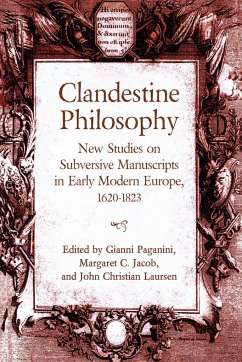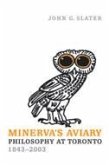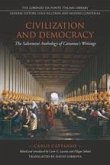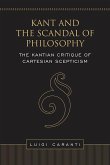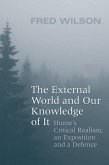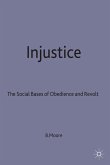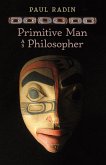Gianni Paganini, Margaret C. Jacob, J.c. LaursenNew Studies on Subversive Manuscripts in Early Modern Europe, 1620-1823
Clandestine Philosophy
New Studies on Subversive Manuscripts in Early Modern Europe, 1620-1823
Herausgeber: Paganini, Gianni; Laursen, John Christian; Jacob, Margaret C
Gianni Paganini, Margaret C. Jacob, J.c. LaursenNew Studies on Subversive Manuscripts in Early Modern Europe, 1620-1823
Clandestine Philosophy
New Studies on Subversive Manuscripts in Early Modern Europe, 1620-1823
Herausgeber: Paganini, Gianni; Laursen, John Christian; Jacob, Margaret C
- Gebundenes Buch
- Merkliste
- Auf die Merkliste
- Bewerten Bewerten
- Teilen
- Produkt teilen
- Produkterinnerung
- Produkterinnerung
Clandestine Philosophy is the first work in English entirely focused on the philosophical clandestine manuscripts that preceded and accompanied the birth of the Enlightenment.
Andere Kunden interessierten sich auch für
![Minerva's Aviary Minerva's Aviary]() John G SlaterMinerva's Aviary82,99 €
John G SlaterMinerva's Aviary82,99 €![Civilization and Democracy Civilization and Democracy]() Carlo CattaneoCivilization and Democracy84,99 €
Carlo CattaneoCivilization and Democracy84,99 €![Kant and the Scandal of Philosophy Kant and the Scandal of Philosophy]() Luigi CarantiKant and the Scandal of Philosophy64,99 €
Luigi CarantiKant and the Scandal of Philosophy64,99 €![The External World and Our Knowledge of It The External World and Our Knowledge of It]() Fred WilsonThe External World and Our Knowledge of It128,99 €
Fred WilsonThe External World and Our Knowledge of It128,99 €![Ghosts Ghosts]() Peter BuseGhosts75,99 €
Peter BuseGhosts75,99 €![Ghosts Ghosts]() Peter BuseGhosts75,99 €
Peter BuseGhosts75,99 €![Primitive Man as Philosopher Primitive Man as Philosopher]() Paul RadinPrimitive Man as Philosopher23,99 €
Paul RadinPrimitive Man as Philosopher23,99 €-
-
Clandestine Philosophy is the first work in English entirely focused on the philosophical clandestine manuscripts that preceded and accompanied the birth of the Enlightenment.
Hinweis: Dieser Artikel kann nur an eine deutsche Lieferadresse ausgeliefert werden.
Hinweis: Dieser Artikel kann nur an eine deutsche Lieferadresse ausgeliefert werden.
Produktdetails
- Produktdetails
- Verlag: University of Toronto Press
- Seitenzahl: 448
- Erscheinungstermin: 11. Februar 2020
- Englisch
- Abmessung: 231mm x 155mm x 38mm
- Gewicht: 748g
- ISBN-13: 9781487504618
- ISBN-10: 1487504616
- Artikelnr.: 54620077
- Herstellerkennzeichnung
- Libri GmbH
- Europaallee 1
- 36244 Bad Hersfeld
- gpsr@libri.de
- Verlag: University of Toronto Press
- Seitenzahl: 448
- Erscheinungstermin: 11. Februar 2020
- Englisch
- Abmessung: 231mm x 155mm x 38mm
- Gewicht: 748g
- ISBN-13: 9781487504618
- ISBN-10: 1487504616
- Artikelnr.: 54620077
- Herstellerkennzeichnung
- Libri GmbH
- Europaallee 1
- 36244 Bad Hersfeld
- gpsr@libri.de
Gianni Paganini is Professor in the Dipartimento Studi Umanistici at Università del Piemonte Orientale. Margaret C. Jacob is Professor in the Department of History at the University of California, Los Angeles. John Christian Laursen is Professor in the Department of Political Science at the University of California, Riverside.
Preface
Introduction: What is a Philosophical Clandestine Manuscript?
Part One: Clandestinity, the Renaissance, and Early Modern Philosophy
1. Why, and to What End, Should Historians of Philosophy Study Early Modern
Clandestine Texts?
2. The First Philosophical Atheistic Treatise: Theophrastus redivivus
(1659)
Part Two: Politics, Religion, and Clandestinity in Northern Europe
3. Danish Clandestina from the Early Seventeenth Century: Two Secret
Manuscripts and the Destiny of the Mathematician
4. "Qui toujours servent d’instruction": Socinian Manuscripts in the Dutch
Republic
5. "The political theory of the libertines": Manuscripts and Heterodox
Movements in the Early Eighteenth Century Dutch Republic
Part Three: Gender, Sexuality, and New Morals
6. The Science of Sex: Passions and Desires in Dutch Clandestine Circles,
1670-1720
7. Expert of the Obscene: The Sexual Manuscripts of Dutch Scholar Hadriaan
Beverland (1650-1716)
Part Four: Clandestinity and the Enlightenment
8. The Style and Form of Heterodoxy: John Toland’s Nazarenus and
Pantheisticon
9. Philosophical Clandestine Literature and Academic Circles in France
10. Joseph as the Natural Father of Christ: An Unknown, Clandestine
Manuscript of the Early Eighteenth Century
11. Clandestine Philosophical Manuscripts in the Catalogue of Marc Michel
Rey
Part Five: Toleration, Criticism, and Innovation in Religion
12. The Treatise of the Three Impostors, Islam, the Enlightenment, and
Toleration
13. The Polyvalence of Heterodox Sources and Eighteenth-Century Religious
Change
Part Six: Spanish Developments
14. The Spanish Revolution of 1820-3 and the Clandestine Philosophical
Literature
15. The fortuna of a Clandestine Manuscript: An 1822 Spanish Translation of
the Examen critique of 1733
Introduction: What is a Philosophical Clandestine Manuscript?
Part One: Clandestinity, the Renaissance, and Early Modern Philosophy
1. Why, and to What End, Should Historians of Philosophy Study Early Modern
Clandestine Texts?
2. The First Philosophical Atheistic Treatise: Theophrastus redivivus
(1659)
Part Two: Politics, Religion, and Clandestinity in Northern Europe
3. Danish Clandestina from the Early Seventeenth Century: Two Secret
Manuscripts and the Destiny of the Mathematician
4. "Qui toujours servent d’instruction": Socinian Manuscripts in the Dutch
Republic
5. "The political theory of the libertines": Manuscripts and Heterodox
Movements in the Early Eighteenth Century Dutch Republic
Part Three: Gender, Sexuality, and New Morals
6. The Science of Sex: Passions and Desires in Dutch Clandestine Circles,
1670-1720
7. Expert of the Obscene: The Sexual Manuscripts of Dutch Scholar Hadriaan
Beverland (1650-1716)
Part Four: Clandestinity and the Enlightenment
8. The Style and Form of Heterodoxy: John Toland’s Nazarenus and
Pantheisticon
9. Philosophical Clandestine Literature and Academic Circles in France
10. Joseph as the Natural Father of Christ: An Unknown, Clandestine
Manuscript of the Early Eighteenth Century
11. Clandestine Philosophical Manuscripts in the Catalogue of Marc Michel
Rey
Part Five: Toleration, Criticism, and Innovation in Religion
12. The Treatise of the Three Impostors, Islam, the Enlightenment, and
Toleration
13. The Polyvalence of Heterodox Sources and Eighteenth-Century Religious
Change
Part Six: Spanish Developments
14. The Spanish Revolution of 1820-3 and the Clandestine Philosophical
Literature
15. The fortuna of a Clandestine Manuscript: An 1822 Spanish Translation of
the Examen critique of 1733
Preface
Introduction: What is a Philosophical Clandestine Manuscript?
Part One: Clandestinity, the Renaissance, and Early Modern Philosophy
1. Why, and to What End, Should Historians of Philosophy Study Early Modern
Clandestine Texts?
2. The First Philosophical Atheistic Treatise: Theophrastus redivivus
(1659)
Part Two: Politics, Religion, and Clandestinity in Northern Europe
3. Danish Clandestina from the Early Seventeenth Century: Two Secret
Manuscripts and the Destiny of the Mathematician
4. "Qui toujours servent d’instruction": Socinian Manuscripts in the Dutch
Republic
5. "The political theory of the libertines": Manuscripts and Heterodox
Movements in the Early Eighteenth Century Dutch Republic
Part Three: Gender, Sexuality, and New Morals
6. The Science of Sex: Passions and Desires in Dutch Clandestine Circles,
1670-1720
7. Expert of the Obscene: The Sexual Manuscripts of Dutch Scholar Hadriaan
Beverland (1650-1716)
Part Four: Clandestinity and the Enlightenment
8. The Style and Form of Heterodoxy: John Toland’s Nazarenus and
Pantheisticon
9. Philosophical Clandestine Literature and Academic Circles in France
10. Joseph as the Natural Father of Christ: An Unknown, Clandestine
Manuscript of the Early Eighteenth Century
11. Clandestine Philosophical Manuscripts in the Catalogue of Marc Michel
Rey
Part Five: Toleration, Criticism, and Innovation in Religion
12. The Treatise of the Three Impostors, Islam, the Enlightenment, and
Toleration
13. The Polyvalence of Heterodox Sources and Eighteenth-Century Religious
Change
Part Six: Spanish Developments
14. The Spanish Revolution of 1820-3 and the Clandestine Philosophical
Literature
15. The fortuna of a Clandestine Manuscript: An 1822 Spanish Translation of
the Examen critique of 1733
Introduction: What is a Philosophical Clandestine Manuscript?
Part One: Clandestinity, the Renaissance, and Early Modern Philosophy
1. Why, and to What End, Should Historians of Philosophy Study Early Modern
Clandestine Texts?
2. The First Philosophical Atheistic Treatise: Theophrastus redivivus
(1659)
Part Two: Politics, Religion, and Clandestinity in Northern Europe
3. Danish Clandestina from the Early Seventeenth Century: Two Secret
Manuscripts and the Destiny of the Mathematician
4. "Qui toujours servent d’instruction": Socinian Manuscripts in the Dutch
Republic
5. "The political theory of the libertines": Manuscripts and Heterodox
Movements in the Early Eighteenth Century Dutch Republic
Part Three: Gender, Sexuality, and New Morals
6. The Science of Sex: Passions and Desires in Dutch Clandestine Circles,
1670-1720
7. Expert of the Obscene: The Sexual Manuscripts of Dutch Scholar Hadriaan
Beverland (1650-1716)
Part Four: Clandestinity and the Enlightenment
8. The Style and Form of Heterodoxy: John Toland’s Nazarenus and
Pantheisticon
9. Philosophical Clandestine Literature and Academic Circles in France
10. Joseph as the Natural Father of Christ: An Unknown, Clandestine
Manuscript of the Early Eighteenth Century
11. Clandestine Philosophical Manuscripts in the Catalogue of Marc Michel
Rey
Part Five: Toleration, Criticism, and Innovation in Religion
12. The Treatise of the Three Impostors, Islam, the Enlightenment, and
Toleration
13. The Polyvalence of Heterodox Sources and Eighteenth-Century Religious
Change
Part Six: Spanish Developments
14. The Spanish Revolution of 1820-3 and the Clandestine Philosophical
Literature
15. The fortuna of a Clandestine Manuscript: An 1822 Spanish Translation of
the Examen critique of 1733

